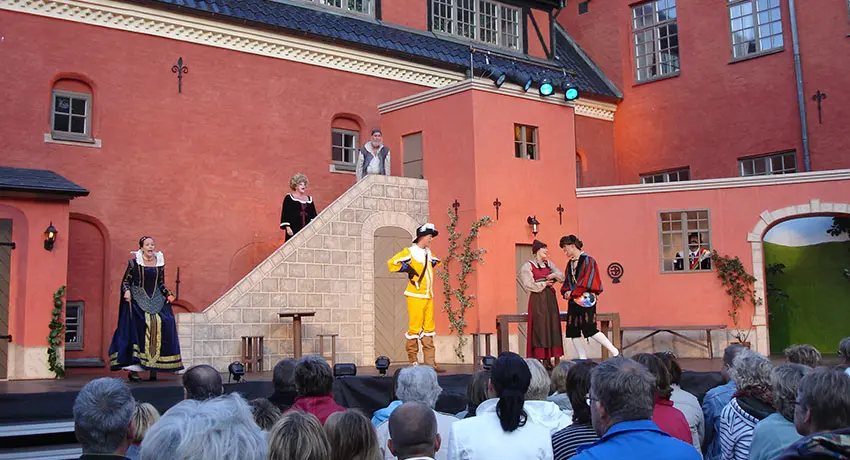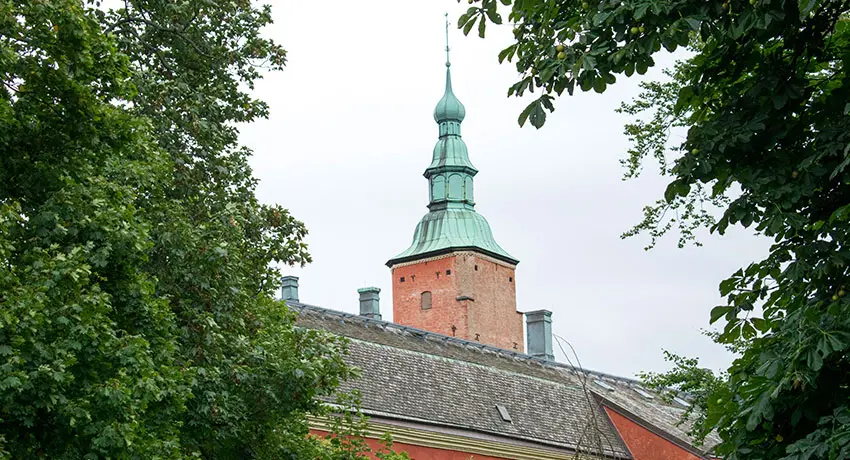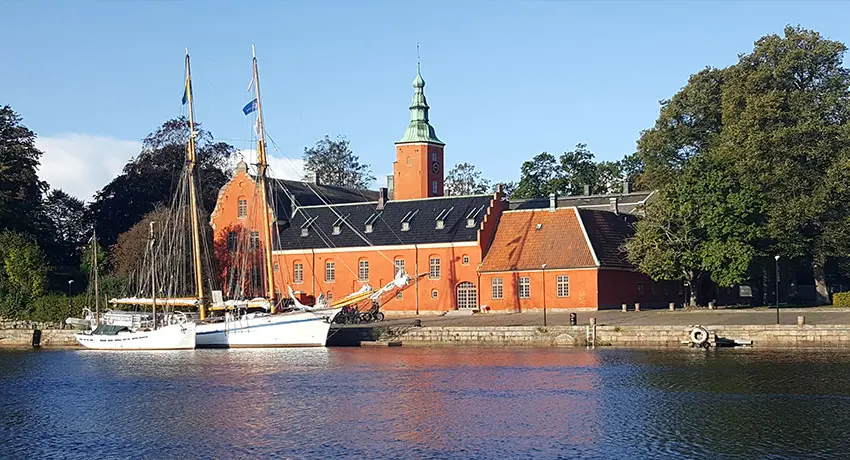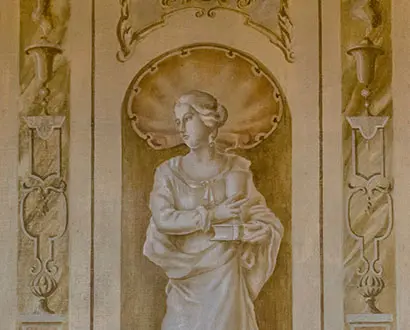- Startsida
- En
- Experience
- Culture and history
- Halmstad Castle
Halmstad Castle
Just two kilometres from the sea, Halmstad Castle is beautifully positioned on the Nissan river. When the castle was built at the start of the 17th century, Halmstad and Halland were Danish. Building was initiated by King Kristian IV of Denmark, who considered he needed a larger, more imposing residence for his visits to Halmstad.

Halmstad castle today
Now, the county governor lives in the castle and the county administrative board has its offices here. In the summer, the castle courtyard is often used for outdoor theatre and music. Every Christmas, an old-fashioned market is held here. Food markets are also staged in the courtyard from time to time.
Sometimes the castle opens up for popular guided tours, if there are any planned guided tours you will find them in our event calendar (Swe).
In 2019, Halmstad Castle was celebrating its 400th anniversary with a number of festivities throughout the year.
South of the castle is the castle park and a few remnants of the fortifications that were erected at the start of the 17th century. In the castle “pond”, there is a work of art, 0 + 0 = 8 or, as it is popularly known, “the 0”. Reflected in the water, this artwork forms an eight – a symbol of eternity and an emblem of Halmstad entering its eighth century as a city.

The castle park with Fredrik Wretman's artwork 0 + 0 = 8
The building of Halmstad Castle
On visits before the building of the castle, the king stayed in the official residence of Sheriff Poul Hvitgelt. This occupied the castle’s current site. The architect and construction manager was Hans van Steenwinckel the Elder. However, he died in 1601 when building was only just starting. Steenwinckel’s pupil, construction manager Willum Cornelissen, took over and finished the castle. Both were of Dutch birth and are buried in St. Nikolai Church. In 1609, work started on converting the residence into a castle and nine adjacent plots were bought.
Comprising five wings around a courtyard, the castle was completed in 1619. The southern wing was most probably built first and included, amongst other things, the king’s apartments. Halmstad Castle was built largely as a palace for entertainment and relaxation. Nonetheless, it was also a place for the king to stay on his inspection rounds. In appearance, it is more like the Danish country mansion houses of that time rather than the contemporaneous, magnificently royal palaces.

King Kristian IV was a great builder and commissioned the building of several towns, castles and fortifications. He was also the commissioner of Halmstad Castle. In the history of Danish architecture, he gave his name to a particular style, Kristian IV Renaissance. Halmstad Castle belongs to this architectural tradition. You can see the style in the narrow, high tower with its pointed roof.
Although he is sometimes referred to as Kristian IV or Christian IV in Swedish, in Danish it was always Christian IV. As his monogram was C4, it is clear that he also used the spelling with C. Thus, Kristian IV it will be, the king has spoken!

Edvin Öhrström's sculpture The Royal Meeting at Halmstad City Hall
The meeting of kings
On 20 January 1619, Sweden was due to make the last payment for the second return of the port of Älvsborg. This had first fallen to the Danes in the Northern Seven Years’ War and then in the Kalmar War. It is said that the sum was handed over at Halmstad Castle. A little over a month later (25 February – 3 March), Sweden’s Gustav II Adolf and Denmark’s Kristian IV met at the castle to discuss collaboration and hold consultations. By all accounts, they amused themselves royally with parties, eating, drinking and dancing for a full week. At that time, a royal banquet could comprise four sessions with twenty courses in each and 35 toasts. The drinks for these latter had to be drained to the bottom. Although they were enemies as regards territory, the two kings are reputed to have liked each other. As Gustav II Adolf expressed it: “The only fault with Kristian IV is that he is my neighbour”. However, it was not long before war returned. The meeting of kings is depicted in a statue next to Halmstad City Hall on Stora torg.
Other royal personages have also visited Halmstad Castle. Queen Christina stayed here in 1654 when she had abdicated the throne of Sweden and was on her way to Rome. Karl XI (Charles XI) held parliament here in 1678. He also stayed here for a week with his wife, Ulrika Eleonora the Elder, after they had married at Skottorp Castle in 1680. Karl XII (Charles XII), Gustav III and Gustav IV Adolf have also visited the castle. Our present King Carl XVI Gustaf and Queen Silvia have visited the castle several times and spent one night here.

The Swedish castle
King Kristian IV could not enjoy the castle for long. In August 1645, it became Swedish. Since 1945, the castle has been used as the county governor’s residence. It is also where royalty stays when visiting Halmstad. Bengt Christoffersson Lilliehöök was the first county governor to live in the castle. The castle has been much extended by various Swedish owners. In 1658, inner fortifications to protect the castle were complete, and the façade windows had been made considerably smaller.
Restorations and murals
Halmstad Castle has undergone several restorations. In the 18th century, the living quarters were rebuilt and the southern and northern wings each had their mansard roof covered with their current slates. At the same time, the tumbledown castle church was turned into a granary. Towards the end of the 1880s, a floor was added to the east wing. To restore the castle’s original character, windows were also replaced. Central heating was installed in 1917.

The castle has been several colours. In the 1770s it was painted yellow. In an attempt to recreate its earliest appearance, the castle was painted salmon pink in 1968. At the next repainting at the end of the 1990s, the castle was given its present colour after pigment from the original paint had been found.
In 2000, National Property Board Sweden decided to restore the state drawing room when it was shown that murals were still intact under the wallpaper that had been hung in the 1960s. On removal of this latter, the strong oil paints were still vivid. Simultaneously with wall restoration, the loose furnishings were renovated and supplemented. Restoration was completed in 2001.

Goddess painted by Stellan Mörner and Esaias Thorén
Art at the castle
From 1920 to 1935, Halmstad Castle was part of art history. Stellan Mörner, the son of county governor Axel Mörner, was a member of the surrealist Halmstad Group of artists. Stellan Mörner and Esaias Thorén were commissioned to decorate the state drawing room with ten, 18th century inspired murals depicting goddesses symbolising the following virtues: hope, happiness, fidelity, chastity, moderation, love, justice, strength, truth and wisdom. These were papered over in the 1960s. However, parts around a door were exposed again in 1975.
Halmstad Castle is now managed by National Property Board Sweden and became national heritage listed in 1935.
More culture and history
More Halmstad
-
Inspiration and guides
Can I bring my dog to Halmstad? No problem!… -
Nature and the outdoor life
Ahh! The Halmstad air! Filled with the tangs… -
Beach and coast
Shimmering sea and colorful sunsets are only… -
Food and drink
Food and drink is not just food and drink.… -
Culture and history
In Halmstad we deliver both culture and history… -
Events
Theatre? Concerts? Art exhibitions? Sport?… -
Spa and wellness
Taking an invigorating dip in the sea, lacing… -
Shopping
Shopping is an experience in itself. Perhaps… -
The Swedish capital of golf
153 golf holes, eight unique resorts in a… -
Good to know
We have gathered together a few practical… -
Accommodation
Where would you like to stay? In a castle… -
Sports and activities
Do you like being active? Raising your pulse,…

















